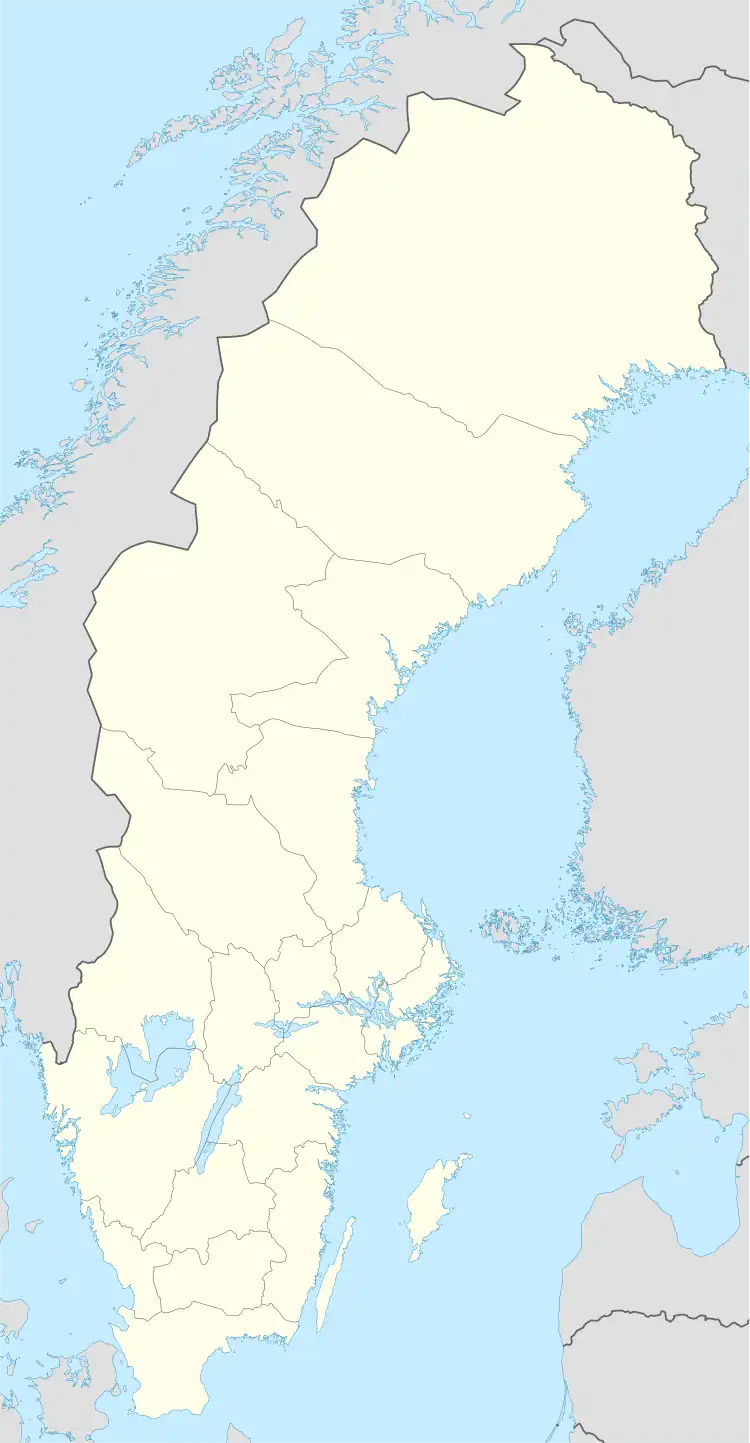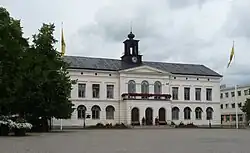Köping | |
|---|---|
 Stora Gatan in Köping | |
 Köping  Köping | |
| Coordinates: 59°31′N 15°59′E / 59.517°N 15.983°E | |
| Country | Sweden |
| Province | Västmanland |
| County | Västmanland County |
| Municipality | Köping Municipality |
| Charter | January 19, 1474 |
| Area | |
| • Total | 11.86 km2 (4.58 sq mi) |
| Population (31 December 2010)[1] | |
| • Total | 17,743 |
| • Density | 1,496/km2 (3,870/sq mi) |
| Time zone | UTC+1 (CET) |
| • Summer (DST) | UTC+2 (CEST) |
Köping is a locality and the seat of Köping Municipality in Västmanland County, Sweden. It had 17,743 inhabitants in 2010.[1] It is known for the television series I en annan del av Köping.
Etymology
Köping means merchant place. It was mentioned for the first time in the 13th century. It was probably given such a name as it did not yet have a charter. The central location of Köping deems it appropriate for merchancy for people from different parts of the country.
History

People have lived on the site for a long time, which is evident not least from the Viking-age boat burial ground at Norsa. An old trading post has been located near Köping. It is first mentioned in a document from the year 1257, when a bishops' meeting was held on the site. Köping, with central and southern Sweden was сhristianised in the 11th century. A church built around the year 1300, the Köping Church, still remains from the early days. Köping has been known as a city since 1349 when its city seal was invoked in a letter.[2]
At Köping was the bailiff's stronghold Köpingshus, mentioned for the first time in 1375 and destroyed by Engelbrekt Engelbrektsson's revolt in 1434.[3] Köping got its charter on January 19, 1474. Köpingshus was rebuilt in the 1580s during Johan III's reign. Charles IX continued the work but later the work ceased and the bail had to lapse. In the 1660s, only ruins remained.[4] Remains remained until the railway was built. Even in the 15th century, the name Laglösa kiöping still appears, which probably means that the trading post had no privileges.[3]
The city's oldest church is probably a church dedicated to St. Olof, which was located after the current Mullgatan. The church appears to have been in poor condition in the early 15th century and then fell into disrepair and was demolished in the 1440s. After the current Köping church was ravaged by fire in 1437, it was given a size sufficient after the rebuilding to suffice for both the county and city parish.[5]
In 1641, Queen Kristina Prästgärdet was donated east of the river to plots, and gradually the "new city" grew here with its own square, Hökartorget or Lilla torget. In the 17th century Köping municipality produced large amounts of iron that was transported to other countries.
In the 19th century Köping established itself as an industrial city, with a large mechanical workshop and a prosperous harbor. A fire in 1889 destroyed large parts of Köping, whereafter it was rebuilt using stone material under supervision of architect Theodor Dahl.
In the 20th century all kinds of companies have established themselves in Köping. Volvo built a large industry there in the 1920s; the arguably most known bed manufacturer in Sweden, Hästens, in 1924; and a number of gold groceries between 1940 — 1960.
Gallery
 The Town Hall in Köping
The Town Hall in Köping Köping church
Köping church Köping railway station
Köping railway station
Sports
The following sports clubs are located in Köping:
- Forsby FF, association football club
- IBK Köping, floorball club
- IK Westmannia Frisk, athletics and ski club
- IKW/Köping BK, bowling club
- Köping FF, association football club
- Köping HC, ice hockey club
- Köping UBBK, basketball club
- Köpings BTK, table tennis club
- Köpings GF, gymnastics and cheerleading club
- Köpings IS, association club, bandy and football
- Köpings RK, riding club
- Köpings SS, swimming club
- Köpings TK, tennis and padel club
- Köping/Kolsva OK, orienteering club
Notable natives
- Carl Wilhelm Scheele — 18th century chemist who discovered the functions of oxygen.
- Richard Dybeck — One of the writers of the Swedish national anthem.
- Henrik Sjögren — Ophthalmologist best known for the eponymous condition Sjögren's syndrome.
- Emir Bajrami — Plays in the Swedish national football team.
- Charta 77 (band) — Swedish punk rock band.
- Johan Gustafsson — Plays professional ice hockey, drafted by Minnesota Wild, plays in Iowa Wild.
- Agda Östlund (1870-1942) suffragist and social democrat
References
- 1 2 3 "Tätorternas landareal, folkmängd och invånare per km2 2005 och 2010" (in Swedish). Statistics Sweden. 14 December 2011. Archived from the original on 27 January 2012. Retrieved 10 January 2012.
- ↑ Carlquist, Gunnar, ed. (1933), Svensk uppslagsbok. Bd 16, Malmö: Svensk Uppslagsbok AB, p. 622
- 1 2 Nordisk familjebok, band 12 (3 ed.), 1930
- ↑ Det medeltida Dalarna och Västmanland - En arkeologisk guidebok, Jonas M. Nordin s. 118
- ↑ Det medeltida Dalarna och Västmanland - En arkeologisk guidebok, Jonas M. Nordin s. 117